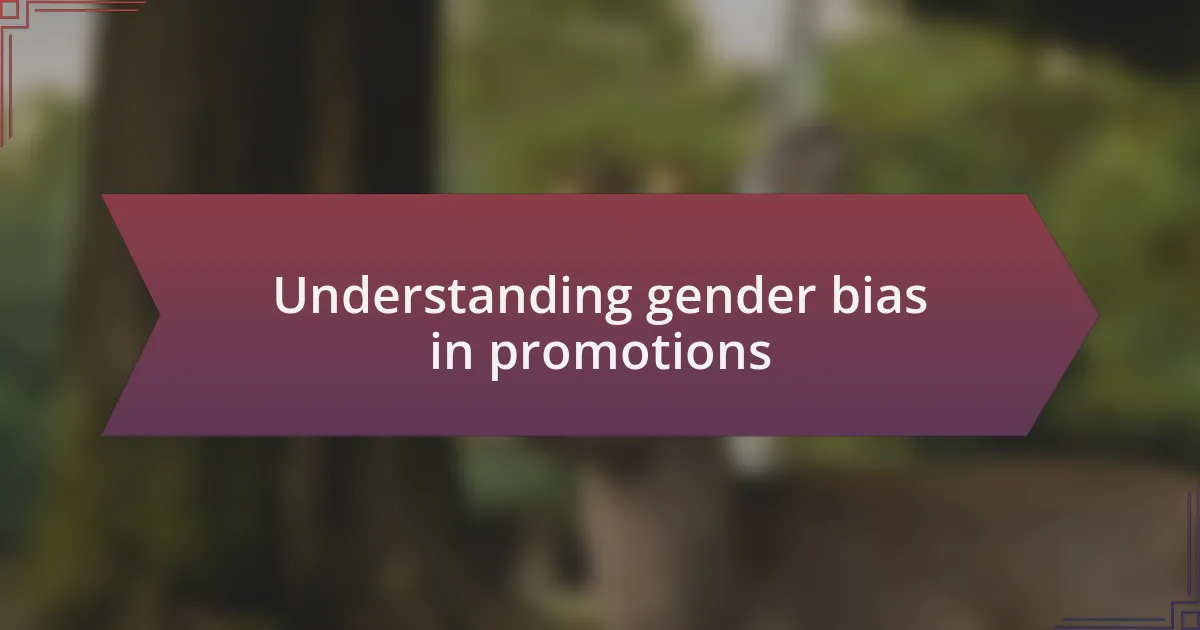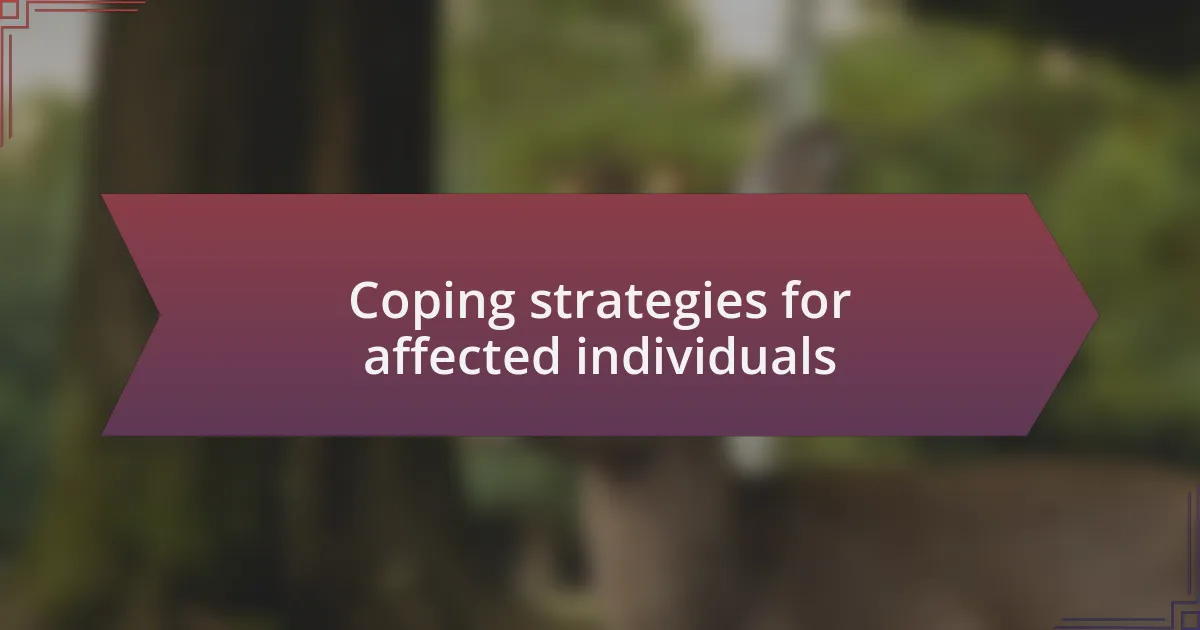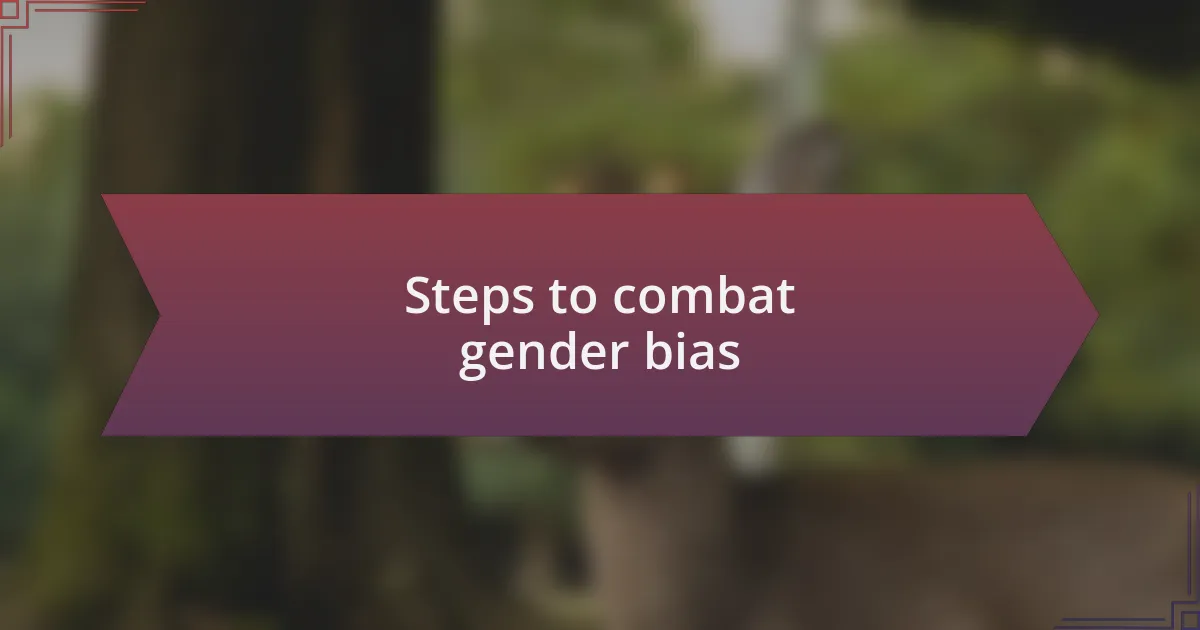Key takeaways:
- Gender bias in promotions frequently disadvantages women, who may be subjected to stereotypes and biased questioning regarding their family responsibilities.
- Legal protections like Title VII exist, but enforcement and cultural shifts toward true equality in promotions remain challenging.
- Personal experiences of bias often lead to feelings of inadequacy and the need for women’s contributions to be validated and recognized.
- Building support networks, seeking mentorship, and advocating for transparent promotion criteria are effective strategies to combat gender bias.

Understanding gender bias in promotions
Understanding gender bias in promotions involves recognizing patterns that often disadvantage women in the workplace. I remember a time when a talented colleague of mine, who consistently delivered outstanding results, was overlooked for a managerial position. This left me questioning: why does merit sometimes take a back seat to assumptions about leadership based on gender?
It’s important to note that women frequently encounter stereotypes that suggest they are less suited for leadership roles. From my own experience, I’ve noticed how often female candidates are asked more about their family responsibilities than their qualifications. This kind of questioning echoes a bias that reinforces the belief that women need to prove their commitment to work, even when their performance speaks for itself.
Moreover, the psychological impact of such biases cannot be overlooked. I’ve felt the frustration and demotivation that comes with seeing less capable male colleagues being promoted simply based on their gender. It makes you wonder how many qualified women are out there waiting for the chance to rise. Wouldn’t it be more beneficial for organizations to prioritize equitable assessments based solely on talent and accomplishment?

Legal framework on gender bias
Legal protections against gender bias are anchored in various laws that aim to create equitable workplaces. For instance, Title VII of the Civil Rights Act prohibits employment discrimination based on race, color, religion, sex, or national origin. I often think about this law as both a shield and a challenge—it’s there to protect, yet the real struggle lies in its enforcement and interpretation within individual workplaces.
Beyond Title VII, many states have enacted their own laws that explicitly target gender discrimination in promotional practices. I once engaged in a discussion with a colleague about how different states approach this issue; we found that some offer more robust protections for workers. However, a common theme emerged: even with these legal frameworks, the cultural shift towards true equality in promotions feels slow and difficult, as systemic biases can often outlast legislation.
Moreover, the Equal Pay Act enhances the legal landscape by addressing pay disparities, which frequently intersect with promotion opportunities. Considering the deep-rooted biases in salary negotiations, I can’t help but wonder how many talented women have compromised on their worth just to be considered for a promotion. It’s disheartening when legal frameworks exist, yet many individuals still feel marginalized due to ingrained stereotypes.

My personal story with bias
Navigating the corporate world, I faced a memorable moment of bias when I was passed over for a promotion I had worked tirelessly for. I remember sitting in the conference room when my male colleague, who had less experience, received the nod. How did I feel? I was initially shocked, then anger surged through me, followed by a deep sense of inadequacy. It made me question if my contributions were being overshadowed by an unspoken bias.
In another instance, I noticed how often my ideas were overlooked in meetings. It always seemed that my suggestions gained traction only after being repeated by a male colleague. A part of me wondered if I was too assertive or if my voice simply didn’t hold weight. I vividly recall a day when I finally addressed this with my manager, only to be met with a dismissive nod, reinforcing what I had suspected all along.
Reflecting on these experiences, I recognize the internal struggle they created. I felt torn between wanting to assert myself and the fear of being labeled as “difficult.” This conflict is common for many women in the workplace. It begs the question: why do we have to work twice as hard just to receive the same recognition? It’s moments like these that fuel my resolve to advocate for change, not just for myself but for all women facing similar challenges.

Coping strategies for affected individuals
Coping with gender bias in promotions requires a multifaceted approach. One effective strategy I discovered is building a support network. Surrounding myself with like-minded colleagues who understand these challenges has been invaluable. I remember one specific lunch where we shared our experiences; it was comforting to realize I wasn’t alone. Has there ever been a time when simply sharing your struggles eased your burden? It definitely did for me.
Emotional resilience has also played a crucial role in my coping mechanism. I learned to reframe rejection as an opportunity for growth rather than a personal failure. After that promotion I missed out on, I took a step back and evaluated what I could learn from the experience. I started seeking feedback actively. It was enlightening to hear different perspectives, which helped clarify my strengths and areas for improvement. How do you respond to setbacks? Shifting my mindset not only empowered me but made me more focused on my goals.
Lastly, I found that advocating for myself was essential in navigating these waters. During performance reviews, I began to prepare detailed reports of my contributions, presenting them assertively. The first time I did this, my heart raced, but I realized that showing my value was empowering. Do others truly see your efforts if you don’t make them visible? This strategy highlighted my achievements, ultimately opening doors I previously thought were closed.

Steps to combat gender bias
One of the most effective steps to combat gender bias in promotions is to seek mentorship from those who have successfully navigated similar challenges. I once reached out to a senior leader, and their insights were truly eye-opening. Have you ever had someone believe in your potential even when you doubted yourself? That’s what mentorship can do—it opens your eyes to opportunities and strategies you might not have considered before.
Additionally, pushing for clear and transparent criteria for promotions can dramatically reduce bias. I remember suggesting a formalized process during a team meeting, and it sparked a vibrant discussion. When everyone knows what the expectations are, it not only holds leadership accountable but also empowers us to align our efforts with tangible goals. Have you seen how clarity can transform ambiguity into action? It certainly did for my team.
Lastly, it’s essential to raise awareness within the organization about gender bias. Initiating diversity training or workshops can create a ripple effect. I coordinated a session that helped colleagues recognize unconscious biases—they were surprised at how pervasive they were. When we bring these issues to light, we inevitably foster a culture of inclusivity. How can we change our environment if we don’t first illuminate the shadows? Addressing these biases head-on can lead to meaningful change for everyone involved.